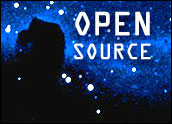
The open source model of developing software is making a significant impact, not only in the software development and broader high-tech community, but more generally within corporations, other types of businesses and organizations around the world, as Part 1 of this series describes.
Whether it’s on servers, desktop computers or mobile devices, it’s increasingly likely that you’re taking advantage of an open source-based product or service.
Linux is an integral part of IBM’s “Big Green” initiative to lower electrical power usage in data centers. Mozilla has followed up on the success of the open source Firefox Web browser with its Thunderbird e-mail service and Minimo browser for mobile devices, while Wikia is beefing up its Web searching capabilities with its Grub Web Crawler.
The open source Asterisk open PBX platform is making inroads within businesses large and small around the world. Wireless sensors using the open source TinyOS are extending network connectivity and computer processing to new levels. Service-oriented architecture (SOA) is providing the framework for the development and deployment of native network application services.
Open source is not only contributing to changing notions of how software can be developed and deployed, but how business operations can be managed and how organizations in general can tap into and leverage the collective knowledge of a much broader range of individuals and groups, both within and outside the organization.
On the Server
IBM and Novell teaming up to provide a distributed, open source application services platform by collaborating to develop their respective WebSphere Application Server Community Edition (WAS CE) and SUSE Linux Enterprise Server products is an illustration of the way open source is making a significant impact in the corporate world, particularly in the retail and financial services sectors, Sandy Carter, IBM vice president of SOA and WebSphere strategy, told LinuxInsider.
The combination “presents the market with more diverse open source options and provides developers with an opportunity to build on a test platform in WAS CE with the full support of IBM and Novell and the open source community as they build their applications,” Carter elaborated.
Providing a new, more robust and flexible framework for developing and deploying network applications and services, the emergence of SOA is another significant marker indicative of the ways open source is having an impact not just within the software development community, but more broadly within the corporate world.
Evolutionary Architecture
Open source standards have been integral to building SOAs.
“There is a mutualistic symbiosis between open source software development and SOA. When you consider that SOA is an evolutionary architecture, you realize that in order to build an SOA, you must integrate and connect disparate sources of information.
“Through open source technology, organizations can more easily build applications and connect disparate parts of the organization. Further, open source software as part of an SOA strategy provides the flexibility to reuse existing services, increases time to value, and enables expanded access to core applications quickly,” Carter explained.
Last month, Arch Rock, a developer of wireless sensor networks (WSN), was the first to show two different implementations of the Internet Engineering Task Force’s (IETF) 6LowPAN standard communicating with each other over a low-power wireless network. Making use of IPv6, the latest version of the Internet Protocol, IETF 6LowPAN defines how IP communication is conducted over low power wireless IEEE 802.15.4 personal-area networks.
“An SOA model that leverages Web services are the de facto means by which modern software programs communicate and Arch Rock is committed to allowing sensor data to be easily consumed by enterprise applications,” David Culler, founder and chief technical officer of Arch Rock, told LinuxInsider.
The data captured and transmitted by Arch Rock wireless sensor networks is integrated within a wide variety of applications and enterprise data management systems through auto-generated Web services, Culler elaborated.
“Each node, or even entire networks, can be viewed as a Web-based application server. Furthermore, application services can be built by authoring simple business logic and pushing it into the appropriate tiers of the Arch Rock embedded network infrastructure. What this means is that developers now need not grapple with the complexities of embedded, distributed systems,” he said. “Rather than require particular, preconfigured applications, the Web services descriptions, discovery and bindings are produced automatically from simple application annotations.”
Open Source VoIP
The open source Asterisk digital PBX (public branch exchange) platform “is the most interoperable, flexible and feature rich PBX in the market today,” asserted Chad Agate, cofounder and CEO of NeoPhonetics.
NeoPhonetics is preparing to release a unified management system for Asterisk that will enable simplified centralized management of distributed Asterisk servers across enterprises, real-time monitoring of network and call quality, and basic reporting associated with Asterisk-enabled call center features.
With a central switching core that includes four APIs for modular loading of telephony applications, hardware interfaces, file format handling, and codecs, Asterisk “allows for transparent switching between all supported interfaces, allowing it to tie together a diverse mixture of telephony systems into a single switching network. It can act as a media gateway for any legacy or VoIP enabled connection available today,” Agate explained.
Worldwide Development Communities
Asterisk’s worldwide open source development community numbers more than 5,000 and the software platform is being downloaded thousands of times each week. “More than 30 different VoIP PBX products are currently based on Asterisk, and more than 30 graphical user interfaces exist for the open source product.
“More than 300 telecommunications consulting firms in the United States provide Asterisk development and integration services. Large enterprise installations have taken place with 10,000 plus users, but the application is used most commonly by the small and medium business market,” Agate told LinuxInsider.
As open source moves to into the mainstream, more mature channels offer open source-based solutions as an option to their customers, said Bill Miller, Digium vice president of product management and marketing.
“Mature applications such as Aspect Software’s IP Contact Center are delivered along with Asterisk Business Edition into global companies, such as an international airline, a major U.S. retailer and a U.S.-based transportation company, among others. Several universities have implemented Asterisk, such as University of Pennsylvania for several thousand phones and users and Sam Houston State University in Texas.”
Wireless, Sensors and the TinyOS
Open source standards have also been instrumental in the rapid development of wireless sensor networks, which have myriad potential applications in environmental management, engineering and operations management.
“Arch Rock benefits quite a bit from open source both in development of our technology as well as helping the WSN market in general. It is our fundamental belief that the more companies and developers building on an open base the faster the pace of innovation,” Culler said.
Leveraging the open standard interfaces developed within the TinyOS alliance imbues the Arch Rock embedded operating system with the ability to run on a wide range of hardware platforms while using the full capabilities of each, Brian Bohlig, Arch Rock’s vice president of marketing, explained.
“Ultimately, this provides the foundation for reliably and efficiently gathering, processing, aggregating, and relaying streams of physical information on current and future embedded hardware,” he said.
Rough Consensus, Running Code
“Open Source has impacted our approach in several ways,” Culler noted. “First, there is a deep connection between open standards and open source. Arch Rock is deeply involved in enabling the next tier of the Internet comprised of billions of devices embedded in the physical world, and we would closely with the Internet Engineering Task Force in that activity.”
Draft standards must be supported by independent implementations to move forward, he said.
“The mantra is ‘rough consensus and running code.’ This is very unusual, as most standards processes are dominated by politics, paperwork, and positioning,” Culler commented.
Much of the success of the Internet is due to the concept that ideas are hashed out in the open by building and connecting working implementations, he added.
“Indeed, the evolution of the Internet is deeply interwoven with BSD Unix — the original open source — and now Linux,” he said.

















































